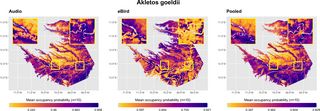Reid Rumelt
@rumeltr.bsky.social
55 followers
140 following
8 posts
PhD candidate at University of Miami. Studying bioacoustics and community assembly in the Neotropics
Posts
Media
Videos
Starter Packs
Reid Rumelt
@rumeltr.bsky.social
· Jul 8
Reid Rumelt
@rumeltr.bsky.social
· Jul 8
Reid Rumelt
@rumeltr.bsky.social
· Jul 8
Reid Rumelt
@rumeltr.bsky.social
· Jul 8
Reid Rumelt
@rumeltr.bsky.social
· Jul 8
Reid Rumelt
@rumeltr.bsky.social
· Jul 8
Reid Rumelt
@rumeltr.bsky.social
· Jul 8

Integrating citizen science data with expert surveys increases accuracy and spatial extent of species distribution models
Aim Information on species’ habitat associations and distributions, across a wide range of spatial and temporal scales, is a fundamental source of ecological knowledge. However, collecting informati...
onlinelibrary.wiley.com
Reid Rumelt
@rumeltr.bsky.social
· Jul 8

Combining acoustic survey and citizen science data yields enhanced species distribution models for tropical rainforest birds
A key goal in ecology is to develop effective ways to understand species’ distributions in order to facilitate both their study and conservation. Many species distribution modeling analyses have been ...
journals.plos.org